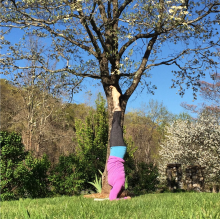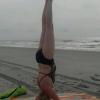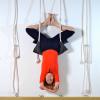Salamba Sirsasana I

Geometry: In this inverted posture the weight of the body is on the forearms and the body is balanced on the head. The torso and legs stretch straight up as in Tadasana.
Orientation in Room: Teach with your back to the students so they can see your shoulders lift up away from the floor. Take beginner students to the wall. If the student's back is on the wall, then do not go up but stay in ardha sirsasana.
Variations From Preliminary Course - Geeta Iyengar:
a. Ardha Sirsasana
b. Urdhva Prasarita Eka Pada Sirsasana
c. Salamba Sirsasana
Actions:
a. Ardha Sirsasana
Place a folded blanket or a sticky mat on the floor against the wall.
Kneel down in front of the blanket, interlock the fingers of your hands, without contracting the palms.
Place the interlocked fingers against the wall with the thumbs up and the little fingers down.
Keep the forearms down and the elbows in line with the width of the shoulders.
Place the crown of the head in the center of the cup formed by the palms of the hands.
Press the wrists down. Lift the shoulders and lift the knees so the legs are straight.
Lift the shoulders without resting the dorsal spine against the wall.
Bend the knees and rest in Adho Mukha Virasana
Common Issues:
Fingers are not fully interlaced.
Wrists do not stay vertical but collapse towards the wall.
Wrists/Forearms do not press down but lift up.
Shoulders collapse towards the floor.
Shoulderblades do not move into the back.
Hips do not lift up towards the ceiling in line with the shoulders.
b. Urdhva Prasarita Eka Pada Sirsasana
Be in Ardha Sirsasana
Keep the toes of the right foot down.
Exhale, Lift the left leg straight up in the air towards the ceiling.
Do Not Drop the Shoulders.
Do not move the elbows out.
Both knees are straight
Do not let the weight of the body fall on to the toes of the right foot.
Exhale, Bring the left foot down.
Keep the toes of the left foot down and lift the right leg
Come back to Ardha Sirsasana
Rest in Adho Mukha Virasana
c. Salamba Sirsasana
Follow the instructions above.
Swing the legs up, one at a time to touch the wall, then straighten the legs.
The whole body is now perpendicular to the floor.
Keep the spine straight, and the shoulders lifted.
Stay for a minimum of one minute in the beginning, breathing evenly, looking straight ahead.
Later extend the duration of the asana from three to five minutes.
Bend the knees and lower the knees and feet to the ground.
Beginner's Tips from Geeta Iyengar's Preliminary Course
Learn to consolidate this position by lifting the shoulders and spine as well as the legs, from the heels to the thighs, upwards towards the buttocks. The leg should become light and the spine firm.
Learn to be out of fear and gear up towards the final position. Learn to shift the weight of the body from the legs to the trunk.
Learn to keep the legs together, back of the heels touching the wall and the buttocks away from the wall without protruding the abdomen.
Preparation for Salamba Sirsasana - Sit in dandasana with the feet touching the wall. Mark where the buttocks touch the floor. Keep the blanket on that line. Do Ardha Sirsasana so you face the wall. Climb up the wall so that the feet and the legs are parallel to the floor. Though the feet are on the wall, learn to lift the spine up independently without falling. This is called Urdhva Dandasana.
In case you are unable to go to the asana by swinging the legs up, then do Urdhva Prasarita Eka Pada Sirsasana against the wall. Now ask someone to lift the already lifted leg to the wall while you take the other leg up against the wall. Once you are established against the wall you do not need assistance. In order to come down ask the assistant to hold one leg against the wall while you descend the other leg to the ground. Once should lift the leg up, alternating the leg.
Sometimes, one should devote time to practice the action of swinging the legs. If the jump is short of length, the legs come down. Therefore, learn to have a high jump. However, do not drop your spine and shoulders, which may injure the neck.
Learn
to keep the body firm and lift up from the floor so it remains light.
to lift the shoulders and cut the shoulder blades in. This major action protects the head and neck. Do not drop the shoulders.
to lift the sides of the chest.
to tighten the hips. Rest only the back of the heels on the wall and the firm trunk is balanced on the tripod of the arms and head.
to keep the spine alert and active. Be attentive so that the legs remain firm.
- Hands interlaced. Lift the head off the floor.
- Dorsal spine to the chair.
- Blocks at the wall. Dorsal spine will not reach the wall.
- Use a narrow folded blanket as a "channel" under the head.
- Squeeze the block between the elbows above the head to learn the actions in the upper arms.
Teachers' photos of this Asana
|
Model: Cora Wen |
Model: Helen Chandler |
Model: Bobby Clennell |
|
|
Model: Anne Jablonski |
Teacher: Megan Bowles |
Are you a Yoga Teacher?
Are you a Yoga Student?
Do you Own a Yoga Studio?









